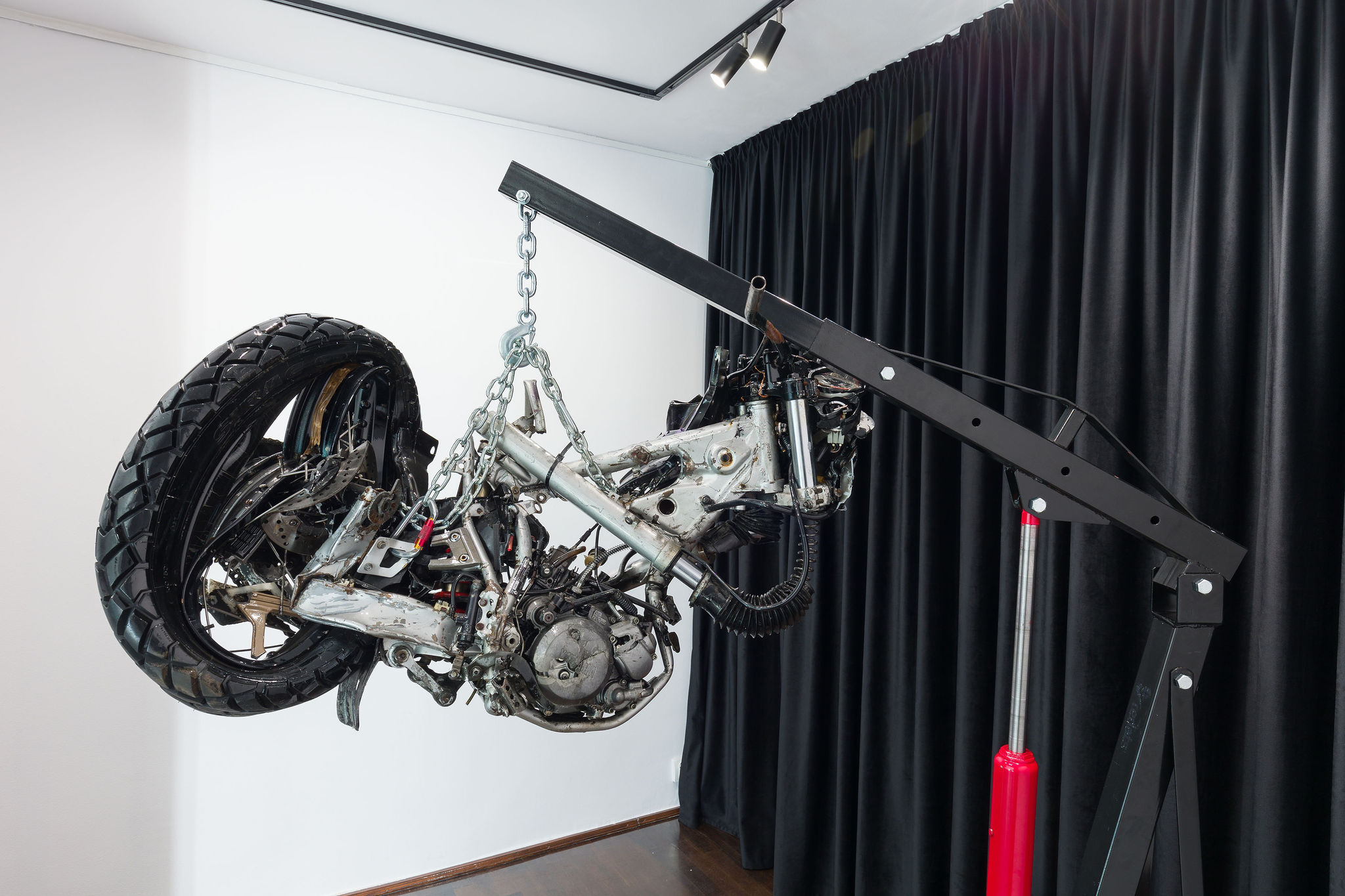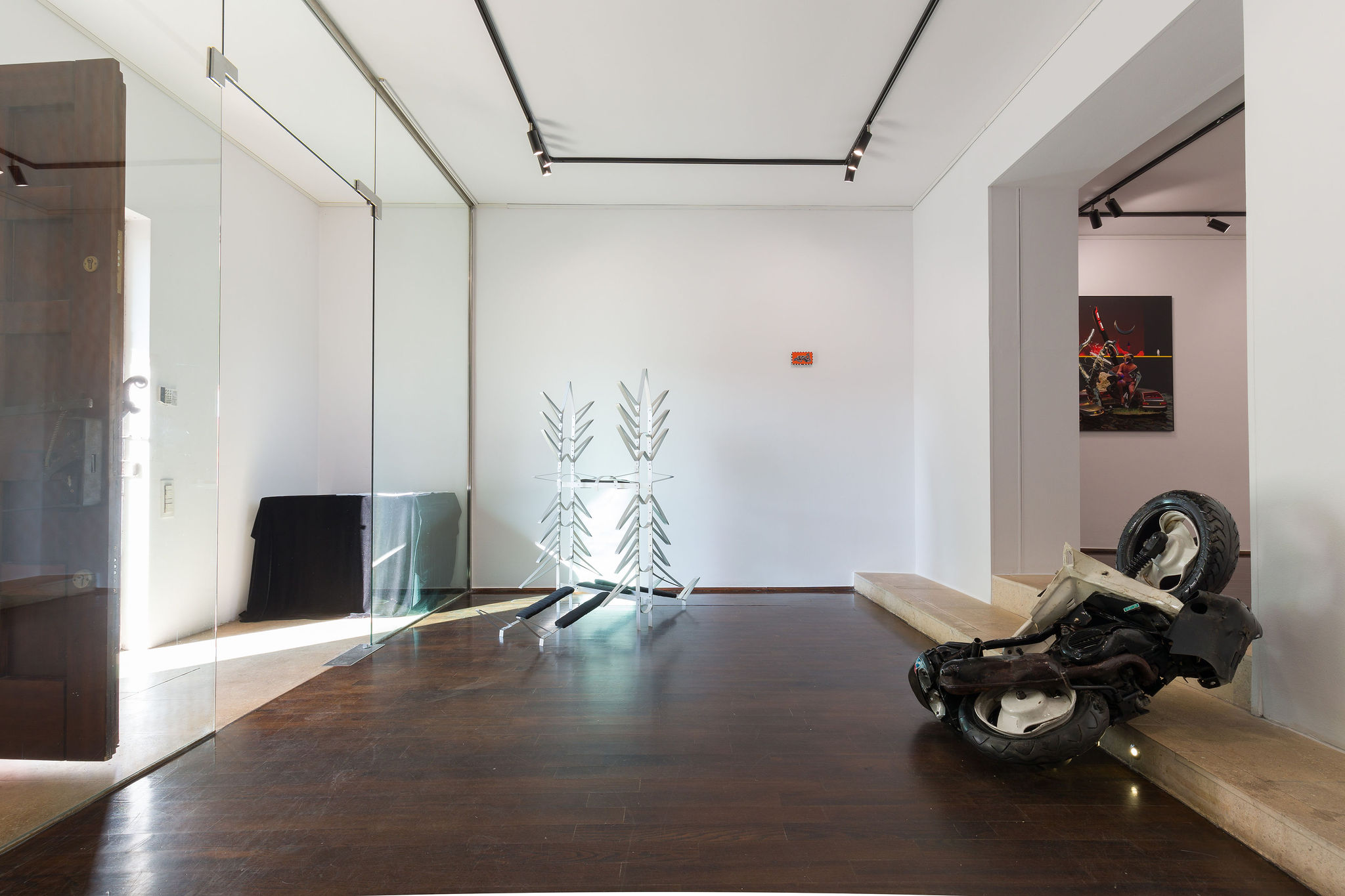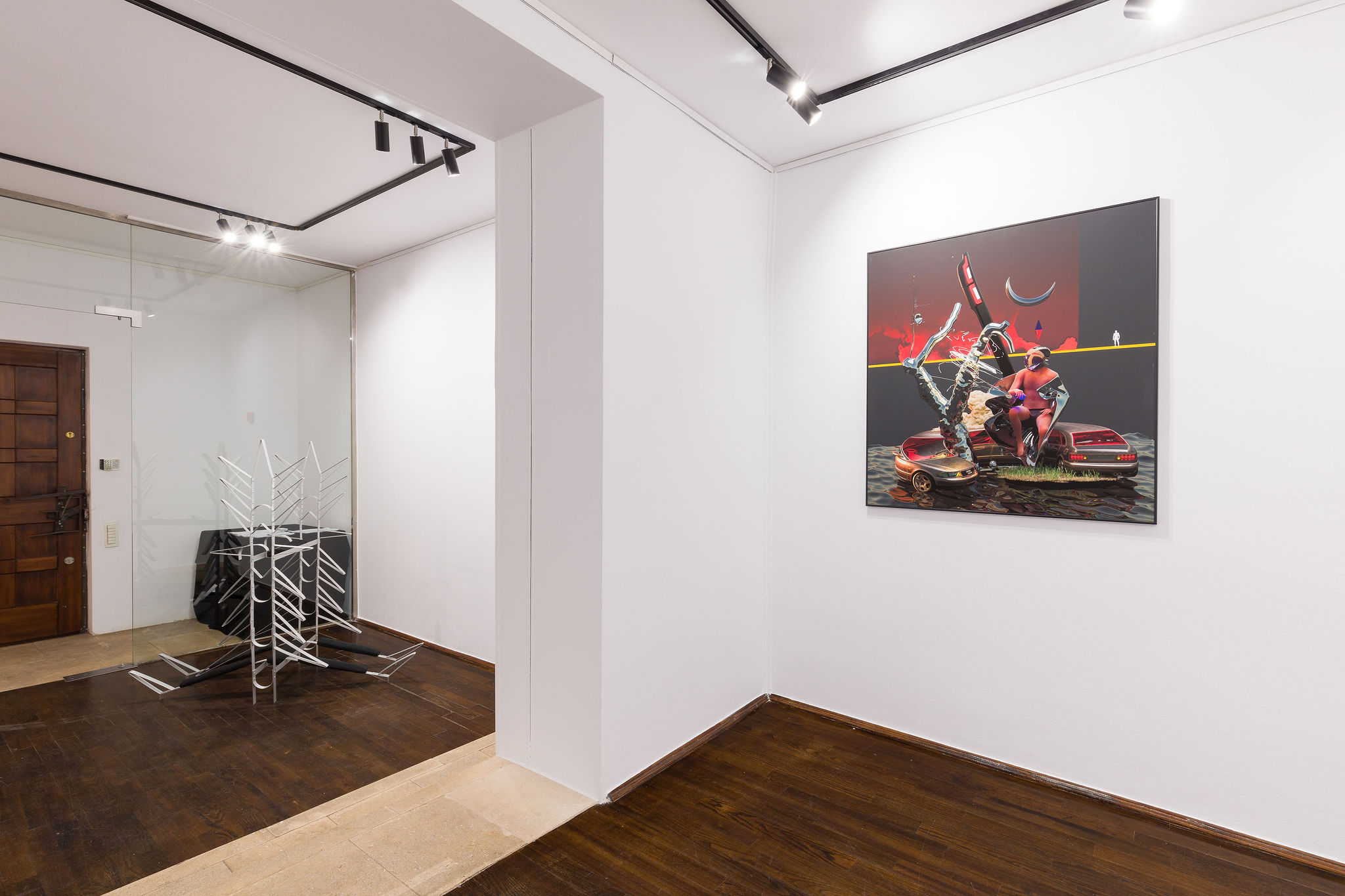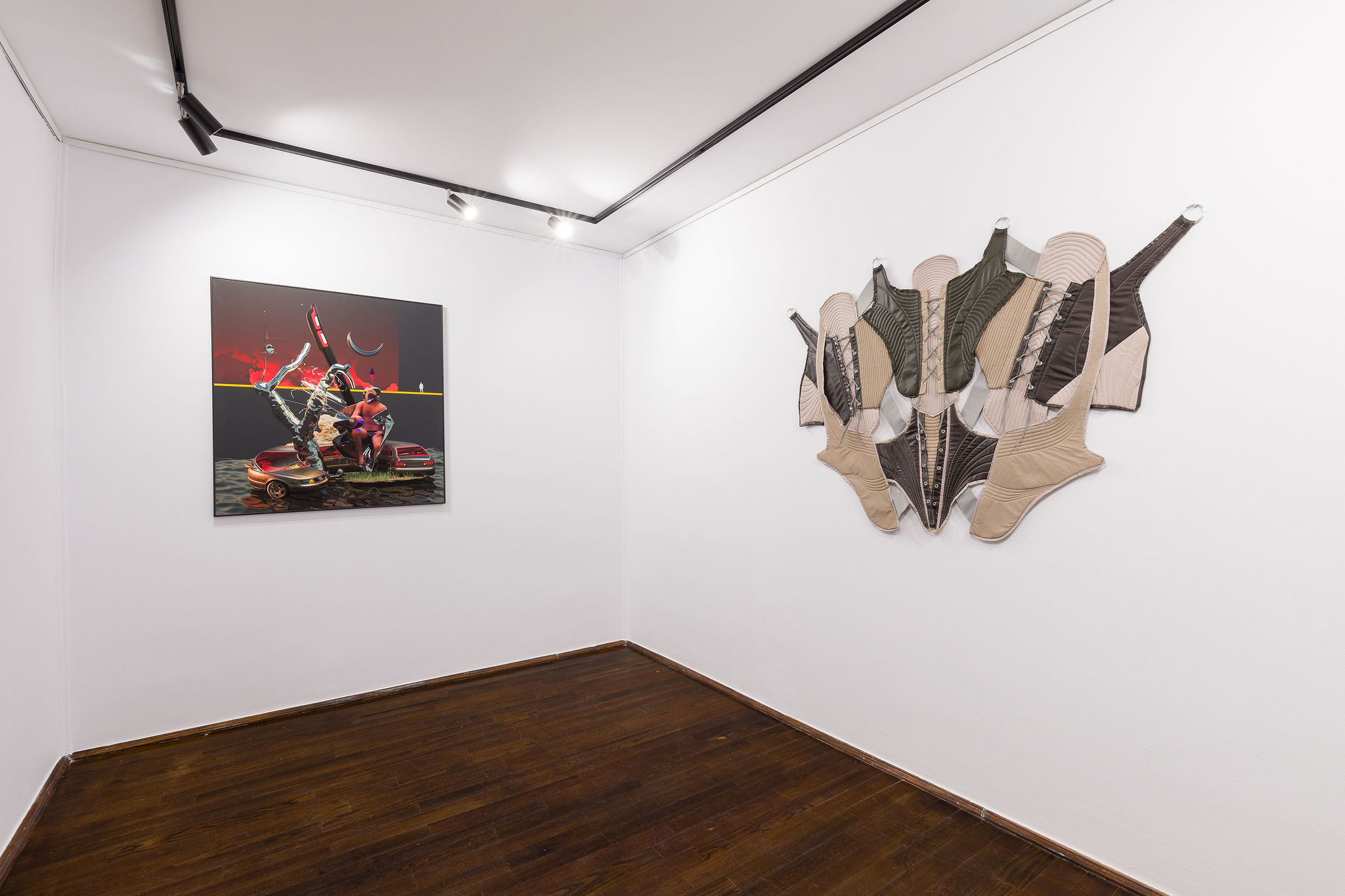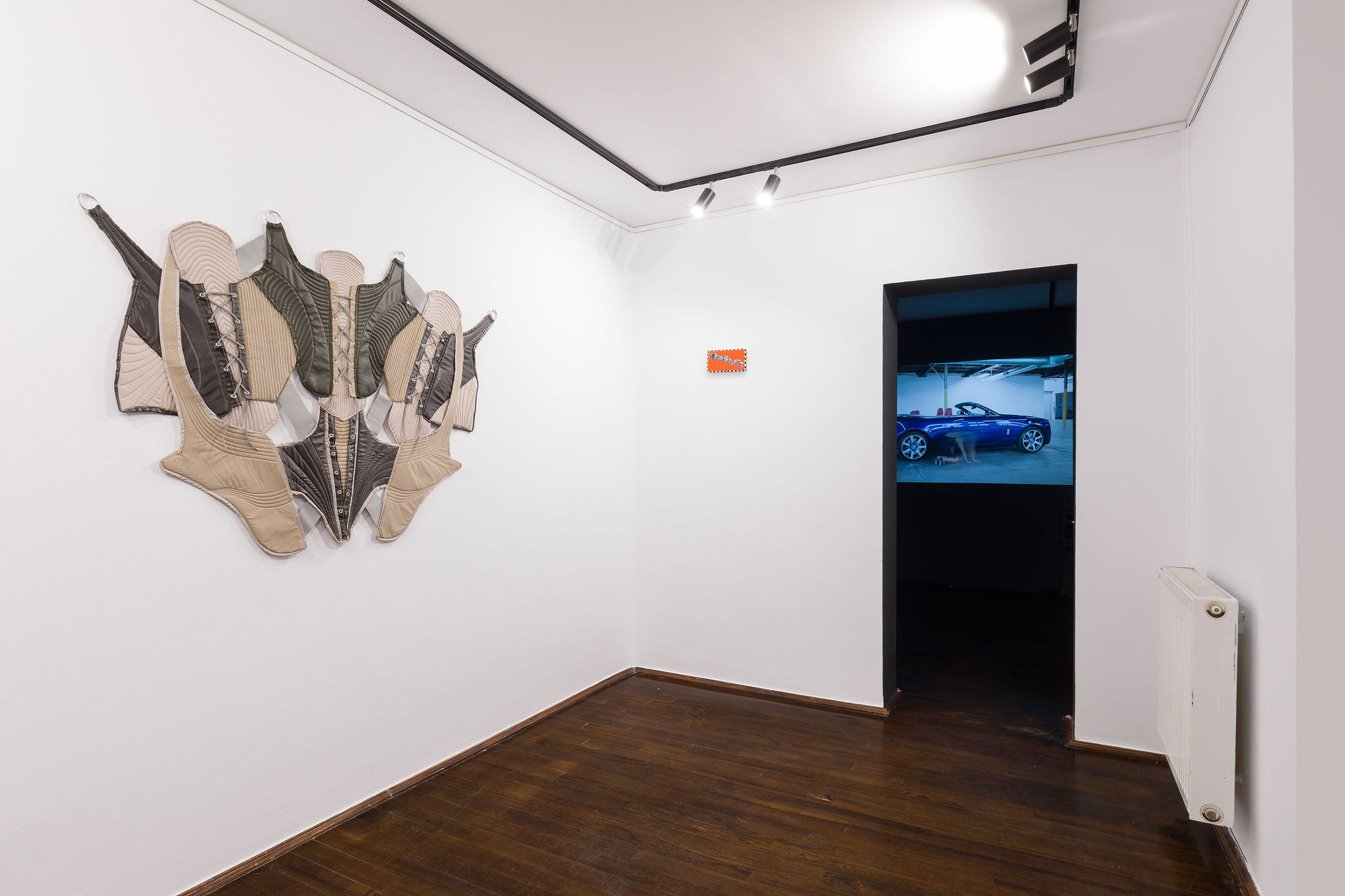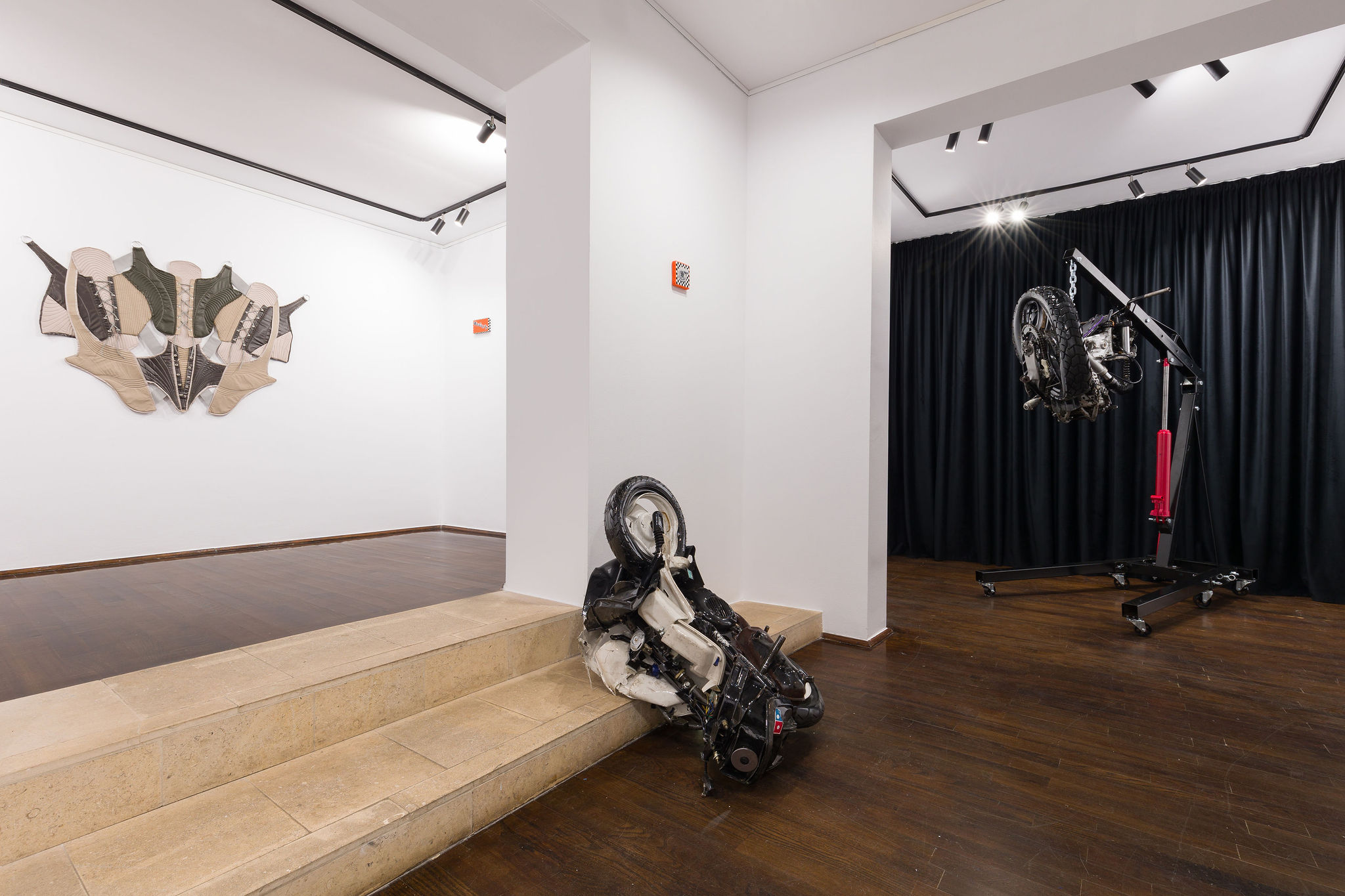
Photo Credits: Y.A.P. Studio - Pavel Curagău
Crash
20. 05. 2022 - 25. 06. 2022
Zina Gallery
Cluj, Romania
Giulia Crețulescu
George Crîngașu
Thea Lazăr
Ioana Sisea
Ștefan Tănase
Curator: Flaviu Rogojan
www.zinagallery.com →
20. 05. 2022 - 25. 06. 2022
Zina Gallery
Cluj, Romania
Giulia Crețulescu
George Crîngașu
Thea Lazăr
Ioana Sisea
Ștefan Tănase
Curator: Flaviu Rogojan
www.zinagallery.com →
For Ballard*, the car crash is a trigger to delve into a new world where the body achieves pleasure only when encased within the sheet metal shell of the automobile, where crashes open up new shapes and orifices, and where the erotic status of the car reflects on the 20th century’s relationship with technology. Half a century later, cars still hold their power in shaping society and urban development, and the impact of technology in shaping our bodies is only increasing. In the gallery, recent works by five emerging artists offer glimpses of an accelerating world and its visceral effects. From power relationships that twist up in glossy metal and shiny rubber to car organs that are delicately dissected, high-horsepower engines can rev up to question political status quos. In cleaner garages, polished car paint becomes a mirror to reflect status and access, while comfortably designed ergonomics guide the body’s violent drives.
Ștefan Tănase’s crushed scooters and motorbikes not only reference Ballard’s controversial novel but also reflect on the artist’s own job as a delivery boy for Domino’s Pizza. On the underside of the gig economy, the promise of freedom and flexibility is revealed as precarity and vulnerability. Bike couriers in urban environments are the exposed bodies in traffic driven by monetized incentives to speed up, to turn in more deliveries for faster returns, to develop a need for speed as dictated by the delivery apps. Proximity to accidents is inevitable. As part of a recurring interest in accidents that spawned multiple series of works, Ștefan Tănase’s CANS II and CANS III are a visceral confrontation of twisted metal and violent power. In an earlier exhibition, the artist staged a fictional crash between a car and a courier and, in a move of foreshadowing, anticipated the accident he himself was to be involved in a few months later.
Another kind of need for speed excites the cultures of car tuning and custom engine parts that are illustrated in Thea Lazăr’s detailed hand-stitched tapestries. Resembling metallic intestines, the knotted tubes of an aftermarket turbo modification for the iconic BMW E30 twist and turn to make room to fit a turbocharger in the tight space of the engine bay. Besides more power and speed, such modifications also bring the drivers and tuners closer to the car, handling it with care, intimately knowing all its parts and insides, feeling the body of the car as a body of one’s own. Translating the precious shine of brand new custom auto parts, Thea Lazăr’s small scale textiles offer warm and delicate textures to organs that uncannily seem soft.
Giulia Crețulescu’s works are part of her long-term artistic research in the ergonomic designs of protection, prosthetics, and tools that silently shape the body and diminish or amplify its vulnerabilities. Camouflaged by comfort, the assumptions and imperatives of such designs are often left unquestioned.
Ștefan Tănase’s crushed scooters and motorbikes not only reference Ballard’s controversial novel but also reflect on the artist’s own job as a delivery boy for Domino’s Pizza. On the underside of the gig economy, the promise of freedom and flexibility is revealed as precarity and vulnerability. Bike couriers in urban environments are the exposed bodies in traffic driven by monetized incentives to speed up, to turn in more deliveries for faster returns, to develop a need for speed as dictated by the delivery apps. Proximity to accidents is inevitable. As part of a recurring interest in accidents that spawned multiple series of works, Ștefan Tănase’s CANS II and CANS III are a visceral confrontation of twisted metal and violent power. In an earlier exhibition, the artist staged a fictional crash between a car and a courier and, in a move of foreshadowing, anticipated the accident he himself was to be involved in a few months later.
Another kind of need for speed excites the cultures of car tuning and custom engine parts that are illustrated in Thea Lazăr’s detailed hand-stitched tapestries. Resembling metallic intestines, the knotted tubes of an aftermarket turbo modification for the iconic BMW E30 twist and turn to make room to fit a turbocharger in the tight space of the engine bay. Besides more power and speed, such modifications also bring the drivers and tuners closer to the car, handling it with care, intimately knowing all its parts and insides, feeling the body of the car as a body of one’s own. Translating the precious shine of brand new custom auto parts, Thea Lazăr’s small scale textiles offer warm and delicate textures to organs that uncannily seem soft.
Giulia Crețulescu’s works are part of her long-term artistic research in the ergonomic designs of protection, prosthetics, and tools that silently shape the body and diminish or amplify its vulnerabilities. Camouflaged by comfort, the assumptions and imperatives of such designs are often left unquestioned.
But, we can only see the inner seams of our ‘appendages’ just when we take them off. The bent aluminium shapes of Ergonomic Tendencies – Kneeling device draw out a familiar posture and trigger an embodied feeling. Sharp edges are paired with soft cushions to prosthetically hold a body in a submissive state. Interfaces in all technologies are designed with the human body in mind, and cannot but constrain certain freedoms of movement and limit the actions of the body to operate correctly. Encased in designed pieces and spaces, the body is always guided through such constraints.
The impact of designed spaces and guided interfaces on the body is even more visible in the virtual environments that occupy our screens. George Crîngașu’s digital compositions often bring together architectural elements, desirable assets, blending disparate cultural and art historical references together. In Genetic Observer, a navigator reflects perched on top of a paradoxically bent car. A character profile created to journey through the online parallel worlds, he is at the end of the road trip. His file sharing and file hoarding so far evaded the algorithms that box in preferences, but the clutter accumulated to a turning point.
The action of licking a Rolls Royce in its entirety, Ioana Sisea’s filmed performance in L.A. tackles questions of desire and materialism in our current capitalism-driven society. Dressed as a hostess and wearing the affordable versions of iconic design staples like the black dress and stilettos, her performance is a commentary on class and access to luxury. In the role of the precarious character of the luxury market worker, the action of licking becomes a narcissistic gesture. Always licking her own reflection in the polished paint, but never gaining access to the elegant and comfortable interior of the car, her work asks what are the types of pleasure available to us, and how do we make that judgement? Are these the things that would actually give pleasure or is the pleasure just in the attainment of the difficult to attain and the social superiority it delivers?
* J.G. Ballard’s novel Crash, and the later film adaptation by David Cronenberg, follow the main character (also called Ballard) become increasingly obsessed with car crashes. The story opens with a head-on crash that kills the driver of the other car and puts both him and the wife of the dead man in the hospital for a lengthy recovery. After meeting a mysterious crash enthusiast and wound fetishist posing as a doctor, he is propelled out of numbness and dissatisfaction into a universe of people who are sexually aroused by car crashes. His world becomes a fetishistic cocktail of sex, cars, and pain, where contorted metal and gaping wounds describe the erotic machinery of body confused with technology in its violent dimension.
The impact of designed spaces and guided interfaces on the body is even more visible in the virtual environments that occupy our screens. George Crîngașu’s digital compositions often bring together architectural elements, desirable assets, blending disparate cultural and art historical references together. In Genetic Observer, a navigator reflects perched on top of a paradoxically bent car. A character profile created to journey through the online parallel worlds, he is at the end of the road trip. His file sharing and file hoarding so far evaded the algorithms that box in preferences, but the clutter accumulated to a turning point.
The action of licking a Rolls Royce in its entirety, Ioana Sisea’s filmed performance in L.A. tackles questions of desire and materialism in our current capitalism-driven society. Dressed as a hostess and wearing the affordable versions of iconic design staples like the black dress and stilettos, her performance is a commentary on class and access to luxury. In the role of the precarious character of the luxury market worker, the action of licking becomes a narcissistic gesture. Always licking her own reflection in the polished paint, but never gaining access to the elegant and comfortable interior of the car, her work asks what are the types of pleasure available to us, and how do we make that judgement? Are these the things that would actually give pleasure or is the pleasure just in the attainment of the difficult to attain and the social superiority it delivers?
* J.G. Ballard’s novel Crash, and the later film adaptation by David Cronenberg, follow the main character (also called Ballard) become increasingly obsessed with car crashes. The story opens with a head-on crash that kills the driver of the other car and puts both him and the wife of the dead man in the hospital for a lengthy recovery. After meeting a mysterious crash enthusiast and wound fetishist posing as a doctor, he is propelled out of numbness and dissatisfaction into a universe of people who are sexually aroused by car crashes. His world becomes a fetishistic cocktail of sex, cars, and pain, where contorted metal and gaping wounds describe the erotic machinery of body confused with technology in its violent dimension.
Exhbition Views at Zina Gallery, Cluj, Romania

